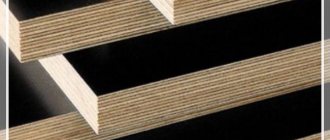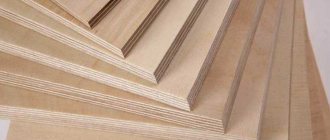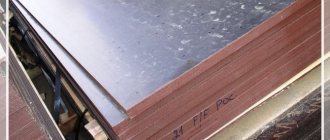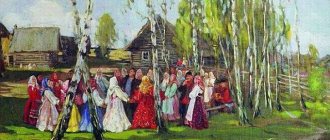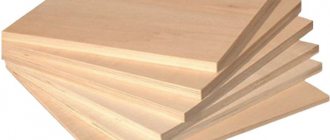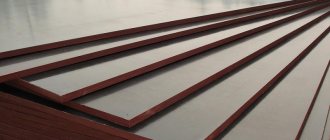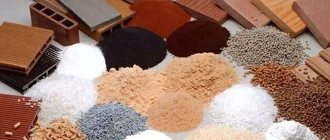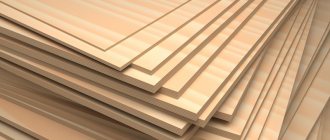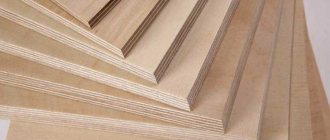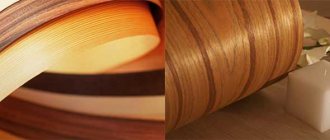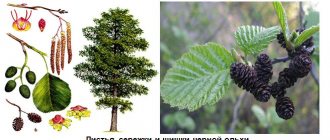Plywood is a multilayer building material that is made from environmentally friendly raw materials - wood. Namely, it is made from wood veneer. This veneer is obtained by peeling wood. In this case, the log is first steamed and then sent to a special machine designed for peeling. After this, the resulting veneer is straightened, subjected to special processing and sent to the dryer. The dried veneer is then subjected to a pressing process and then glued together using various adhesives.
Due to the multilayer structure, the quality indicators of the product increase. The thickness and mass of the material in this case is small. For comparison, the strength of a plywood sheet of a certain thickness is several times higher than the strength of solid wood material. This is due to the fact that veneer is glued so that the fibers of each layer are perpendicular to each other. Therefore, the strength of plywood products is much higher.
| Nominal plywood thickness, mm | Plywood ply, not less | Sanded plywood | Unsanded plywood | ||
| Maximum deviation, mm | Variation in thickness | Maximum deviation, mm | Variation in thickness | ||
| Plywood 3 mm | 3 | +0,3/-0,4 | 0,6 | +0,4/-0,3 | 0,6 |
| Plywood 4 mm | 3 | +0,3/-0,5 | +0,8/-0,4 | 1,0 | |
| Plywood 6 mm | 5 | +0,4/-0,5 | +0,9/-0,4 | ||
| Plywood 9 mm | 7 | +0,4/-0,6 | +1,0/-0,5 | ||
| Plywood 12 mm | 9 | +0,5/-0,7 | +1,1/-0,6 | ||
| Plywood 15 mm | 11 | +0,6/-0,8 | +1,2/-0,7 | 1,5 | |
| Plywood 18 mm | 13 | +0,7/-0,9 | +1,3/-0,8 | ||
| Plywood 21 mm | 15 | +0,8/-1,0 | +1,4/-0,9 | ||
| Plywood 24 mm | 17 | +0,9/-1,1 | +1,5/-1,0 | ||
| Plywood 27 mm | 19 | +1,0/-1,2 | 1,0 | +1,6/-1,1 | 2,0 |
| Plywood 30 mm | 21 | +1,1/-1,3 | +1,7/-1,2 | ||
The smallest number of layers is three, that is, one of them is intermediate, covered with two front layers. If the product has a larger number of layers, most often it is an odd number. Due to several additional layers, the strength increases, and therefore the quality of the material, but at the same time the thickness of the plywood board and its weight increase slightly.
| Length (width) of plywood sheets | Maximum deviation |
| 1200, 1220, 1250 | +/- 3,0 |
| 1500, 1525, 1800, 1830 | +/- 4,0 |
| 2100, 2135, 2440, 2500 | +/- 4,0 |
| 2700, 2745, 3050, 3600, 3660 | +/- 5,0 |
Plywood is classified by grade, material used as raw material and by impregnation, that is, by the glue that is used to glue the material.
Characteristics of plywood varieties
- The best option is elite plywood building material - grade E. There are no defects on the surface of such a coating, which usually arise due to low-quality raw materials.
- First grade plywood may have minor defects or small cracks, but in this case the length of such areas should be within two centimeters.
- The second grade is assigned to material that has certain drips of adhesive or other inclusions. In this case, the volume of such defects should be no more than two percent of the total area of the material. The length of cracks or drips should be about 18-20 cm.
- The third grade is characterized by the presence of black spots, the diameter of which does not exceed 0.5 cm, and the number of such defects should be within 10 when examining one square meter of plywood board.
- The fourth grade is characterized by the lowest quality. In this case, wormholes, damage to sheet edges, fallen knots, etc. are allowed. This building material is most often used for rough work.
Standard sizes and thickness of plywood
Manufacturers offer a wide range of board materials in various formats. For all existing types of plywood, both thickness and dimensions are determined in accordance with the relevant GOST standards for coniferous and deciduous panels. The standards establish sixteen values for the length and width of sheets, which range from 1200 to 3660 mm. The maximum deviation from the above parameters should not exceed 3 to 5 mm.
The nominal thickness of the mentioned panels ranges from 3 to 40 mm with the number of layers of rotary-cut veneer from 3 to 21. In total, there are 11 types of slab materials, distinguished by this parameter.
To answer the question of how thick plywood is, you should familiarize yourself with the mentioned standard. The document provides for the possibility of producing sheets of other standard sizes as agreed between the manufacturer and the consumer. Domestic and imported board materials presented on the Russian market are certified and are of excellent quality. Coniferous or birch plywood of all types, grades and grades described in the article is intended for use in a variety of fields - construction, furniture production, mechanical engineering, and other industries.
Material for making plywood
It is possible to use both coniferous trees, such as pine, larch, and deciduous trees, for example, birch, as raw materials in the production of plywood material. Valuable species, such as oak or cedar, are used very rarely - to create decorative products. They are characterized by high quality, but have a high cost.
| Indicator name | Thickness, mm | Brand | The value of physical and mechanical indicators | |||
| FSF, FC | ||||||
| Plywood moisture content, % | 3-30 | FC, FSF | 5-10 | |||
| Ultimate strength during static bending along the fibers of the outer layers, MPA, not less | 7-30 | 25 | ||||
| Tensile strength along the fibers, MPA, not less | 3-6,5 | 30 | ||||
| Hardness, MPa | 9-30 | 20 | ||||
| Sound insulation, dB | 6,5-30 | 23,0 | ||||
| Biological resistance, hazard class | 3-30 | 5fDa, St | ||||
Coniferous trees are considered the most popular raw material used for the production of plywood boards. The bulk of such products in construction markets are made from precisely such raw materials. This type of plywood sheet is mainly used for rough construction work, as well as in rooms where the use of environmentally friendly material is important.
General information about FC plywood
| Birch plywood FK nsh GOST is characterized by average moisture resistance, made from veneer of coniferous or mixed wood, which is glued with urea glue. With average moisture resistance, the average moisture content of the sheets should be in the range from 5% to 10%, and the main application is decoration and indoor use, drawers and boxes are also made from it, and is also actively used in furniture production. The price level for FK e1 plywood is in the lower range and is a guideline for builders using this material indoors. |
Softwood Plywood
One of the most important advantages of this building material made from coniferous wood is its low cost. Thanks to this, plywood can be used to assemble furniture and various other structures. Plywood products are also used for rough work, that is, in work where the appearance of the material does not play a major role.
A big plus of this material is its resistance to moisture. This is due to the fact that coniferous materials have many natural resins in their structure, which provide plywood with high resistance to the negative effects of moisture. Moreover, this does not require any additional impregnation. Also, such resins of natural origin have antiseptic properties, that is, mold will not appear on such a surface and the plywood will not be destroyed by various insect pests.
Along with the advantages, this material also has some disadvantages. One of them is low strength. For this reason, plywood made from coniferous wood is not recommended for use for flooring and other products where the strength of the material should be the main indicator.
Excessive resin content in such products is also a disadvantage of this coating. When plywood is heated, the release of these tarry substances may begin, which is generally unacceptable.
FC moisture resistant plywood
The moisture resistance of plywood FC GOST 3916.1 96 is not increased, but at the same time it will not immediately become wet when exposed to moisture or in a humid environment. But the most optimal use of such moisture-resistant FC plywood is interior finishing and cladding of internal surfaces. If you know in advance that the surface to be sheathed is located in a dry, closed room, then it makes sense to save on purchasing moisture-resistant plywood. The ease with which moisture-resistant plywood sheets can be cut, drilled, sawed with ordinary tools and basic skills is another of its many advantages. This material is an ideal choice for cabinets, built-ins, shelving and similar applications for the same reasons - good appearance and reasonable cost. FC plywood is moisture resistant and is also widely used as a substrate for other finishing materials. For walls, for example, it serves as an excellent wall covering, for rare hardwoods, vinyl surfaces and decorative fabrics.
Plywood FC NSh
Unsanded FC plywood is widely used in material handling applications including pallets, pallet bins and tanks, liquid tanks, containers, shelving and cable drums. Non-sanded FC NSh plywood is especially well suited for processing materials in applications where the conditions for packaging goods or material assets that are transported or stored are not particularly important. For example, containers intended for packaging soft fruits or vegetables are usually made of unsanded FC plywood. Likewise, lined pallets can reduce damage to goods that might be knocked off or snagged when using more abrasive surfaces.
Hardwood Plywood
In this case, birch veneer is most often used. Birch is the most commonly used species of deciduous species. Plywood using birch as a raw material is produced much less frequently, but it is characterized by better quality and strength indicators compared to its coniferous counterparts.
The advantages of birch plywood include the strength of the material and resistance to wear. Thanks to this, such plywood sheets can be used in various construction works and in the creation of any structures. Plywood boards made from hardwood are characterized by high wear resistance.
The disadvantage of birch-based material is its high price. For this reason, this material is not used as widely as its coniferous counterparts.
Another disadvantage of this material is the lack of natural resins. Birch veneer is not resistant to moisture, therefore, it requires special impregnation, which makes the product environmentally unclean. This can only be avoided if an albumin-casein adhesive is used. But even this treatment is not able to increase the moisture resistance of the plywood sheet.
The use of special impregnations and adhesive mixtures is also a kind of disadvantage in the production of products based on hardwood.
To connect the layers of veneer into a solid coating, glue is used, which at the same time is an impregnation. The components of such impregnation determine what technical indicators the finished product will ultimately receive. Depending on the chosen adhesive composition, plywood is divided into several types.
Main technical characteristics
The main characteristics of FC plywood include:
Thickness of the FC plywood sheet and its main parameters.
- Ease of processing. This applies to both sawing and drilling. To cut the plywood, you can use an electric jigsaw or saw. However, to obtain a smooth edge without nicks or chips, it is recommended to use a file with fine teeth. This is the tool that will allow you to get a smooth cut edge. In order to make a hole in a FC plywood sheet, a drill for any material is suitable, except for those drills that are designed for working with concrete.
- Bond strength. Plywood sheets are attached quite firmly both to each other, if necessary, and to any surface using self-tapping screws. Fastening sheets of plywood together is possible using the butt-to-butt or miter method. In this case, the butt joint will have less strength than the miter joint. The mustache is made with a plane, finished with a grinding machine, and then, after applying an adhesive solution, it is clamped with clamps. This method ensures reliable and strong fastening of plywood sheets to each other, which allows the resulting plywood sheet to be used for its intended purpose in the future.
- Versatility of use. FK plywood of various grades and with varying degrees of processing of the top layer can be used both for construction work and for furniture production.
Classification of plywood by type of glue
In the production of FBA plywood, an albumin-casein adhesive mixture is used, which is based on natural components. Consequently, such plywood will be environmentally friendly, its components will not cause any harm to human health and will not cause allergies. Thanks to this, such building material can be used when decorating a children's room.
But this product also has some disadvantages, such as low strength and moisture absorption. Even impregnation in this case does not give the plywood sufficient strength. Since wear resistance largely depends on the type of wood used. This glue is water-soluble, which means that this plywood board is highly susceptible to moisture.
FSF plywood is considered the most commonly used type in the construction industry. This material is based on a phenol-formaldehyde adhesive composition. It is used to impregnate and glue wood fibers. This glue makes the material more durable and resistant to moisture. Due to this, the scope of application of phenol-formaldehyde plywood is quite wide, ranging from simple furniture covering to its use as a floor covering.
This option is characterized by optimal cost. The disadvantage of such plywood is its lack of environmental friendliness. That is, if such material is heated, formaldehyde will begin to be released, which negatively affects human health.
| Emission class | Formaldehyde content per 100 g of absolutely dry plywood weight, mg . |
| E1 | Up to 10 incl. |
| E2 | From 10 to 30 incl. |
There is another type of plywood on the construction markets - FB. In this case, the glue is bakelite varnish. These products are highly durable and have excellent moisture resistance. The downside of bakelite plywood is the large weight of one sheet and a fairly high toxicity rate.
Aviation plywood | Use of aircraft plywood
Aviation plywood is made from high-quality birch veneer, has three or more layers glued together, and, with its relatively low density, has excellent flexibility and strength. Thus, aircraft type plywood with a thickness of three to sixteen millimeters or even more can be used not only for aircraft modeling, but also for musical instruments. The thinnest sheet can be 1 mm thick.
Let's talk about what properties the material for making structures has, as well as what brands it has and where it is used.
Manufacturing of aircraft plywood
This type of plywood is also called delta wood, which is essentially similar to aircraft plywood, because it is made from exactly the same birch veneer with the addition of plastic. Before gluing the layers with bakelite adhesive, they should be impregnated with phenol-formaldehyde resin at a temperature of 270 degrees and a pressure of six atmospheres. This material is produced only in accordance with GOST 226-41, and also has grades A and B.
Production and marking of aircraft plywood
Thus, the products can be divided into several grades: BP (A or B) - this applies to this type of plywood sheets that are glued with bakelite film type A or B. There is also the BS-1 grade, in which the veneer is glued using SFZh-resin 3011 and BPS-1V. This indicates that up to three millimeters the product is glued to a bakelite film with type B, and then the same with type A is used, but only on the outer layer, and resin is used on the inside.
When producing plywood with this marking, it is necessary that the veneer be positioned perpendicularly. In other words, in their direction, the fibers of each layer intersect with each other, thereby creating something like a structural lattice, with the help of which the strength of the manufactured structures becomes much greater.
The increase in strength level related to the tensile strength of structural wood directly depends on its decreasing thickness and for products with the first grade is 65-95 MPa and the second - 50-82.5 MPa. If the thickness of the material becomes smaller, then its tensile strength, on the contrary, becomes greater. This concerns the formation of chips in the adhesive layer. Their size ranges from 1.6-2 MPa. The most optimal level of surface roughness for aircraft plywood sheets is 100 microns at a moisture level of 5-9%.
The length of the geometric data of this type of wood ranges from 1000 to 1525 mm, and the width from 800 to 1525 mm. The permissible gradation value is twenty-five millimeters. Sheets with the BP brand (A or B) can have a thickness from one to three millimeters, but for BS up to twelve, and for BPS from two to six.
Thus, aircraft-type plywood formats can have dimensions: 1550x1550, 1525x1525, 1270x1270, 1220x1220. With all this, the thickness can be of various sizes from 0.4 to 12 millimeters.
Any type of plywood is manufactured according to instructions drawn up in accordance with GOST 3916.1-96. The sheet must have an odd number of layers, and the fibers are arranged perpendicular to each other at an angle of ninety degrees, forming a structural lattice. As for the production process of such products, it has several specific stages. Plywood may be marked with the letters Ш and Ш2, which indicates that one-sided or two-sided sanding was carried out. Low grade plywood is not sanded and is marked with the letters NSh.
Applications of aircraft plywood
It has long been known that this type of structural wood was widely used for the construction of aircraft, especially during the war. Due to the fact that the material is relatively light in weight, the car was lightweight, and thanks to its flexibility and strength, it became possible to withstand the aerodynamic load during aircraft operation. Although, in aircraft modeling, aircraft plywood is still used today. In addition to being used in aircraft construction, such plywood sheets are popular in collecting (airplanes or ships). In addition, this material has also gained wide popularity in shipbuilding.
During the architectural machinations of any unique solutions for the construction of various structures (buildings, cities, houses), designers independently make models. On their basis, projects are approved. In addition, with the help of flexible plywood, you can implement non-standard solutions in interior design.
It would also be strange not to mention that musical instruments are made from aircraft plywood . For their production previously it was impossible to do without high-quality plywood sheets. Each of the soundboard instruments requires the use of special wood, and over the past few years, replacing it with plastic has not justified itself; the best sound quality can only be achieved by using natural wood.
Any plywood of the type in question with a thickness of one or more millimeters can always be used at home. Also, some craftsmen can independently assemble furniture from it in several different styles, thereby achieving the beauty of living conditions.
mosfanera.ru
Plywood FC GOST
For example, you don't need to buy an expensive type of plywood that is finished perfectly on both sides as long as only one side is visible. Likewise, there is no point in paying for 1/2-inch thickness when 3/8-inch FC plywood is moisture resistant and is really all that is needed. It also comes with a variety of adhesives and end finishes. Knowing these characteristics will help you save money and also do a better job. For use at home, hardware stores and warehouses, sanded plywood FC GOST 3916.1 96 is better than lumber. It will be stronger, lighter and stiffer. Its impact resistance means that it will not split, crack, or collapse due to expansion and contraction within individual layers. Moreover, you will never get raw wood in the form of sanded FC plywood. When you buy a sheet of plywood FC GOST 3916.1 96, you know exactly what size you are getting, unlike other types of lumber that have nominal and actual measurements.
Plywood FC E1
Class E1 or E2 indicates the degree of formaldehyde content in mg per 100g of dry weight. For class E1 this indicator should be no more than 10 mg for every 100 g of leaf dry weight, and in the case of E2 it should be in the range from 10 to 30 mg for every 100 g of leaf dry weight. Also, this product as a whole can be divided by type of application: external and internal. The outer one is characterized by the presence of waterproof glue in its composition, and the inner one is made using a less waterproof glue, but can actually withstand quite a lot of moisture. There is an interior FC birch plywood made with IMG (intermediate glue) that is resistant to bacteria, mold, and moisture, but is not intended for outdoor use.
Application of FC plywood
- racking systems in warehouses;
- finishing of ceilings and walls;
- for the construction of internal walls;
- for the manufacture of shelves and other various decorative parts;
- for the manufacture of cabinet furniture for a home or office;
- for finishing of bodies in transport, for finishing of bodies and cargo containers;
- in the advertising business;
- cinema;
- industrial modeling;
- art;
- in the production of decorations;
- advertising models and objects;
- souvenirs, toys, household items;
- in acoustics and sound technology;
- for the manufacture of musical instrument bodies;
- containers, packaging, boxes, packing boxes;
- partitions for transportation;
- as a base for parquet or laminate;
- for preparing signs and stands intended for indoor use;
- some parts of sofas, armchairs;
- for creating balcony ceilings and partitions;
- combined thermal insulation device;
- creation of insulating products in electrical engineering;
- models of ships, airplanes;
Reviews about FC plywood
Send your feedback, complaints and suggestions on the quality and use of plywood grade FK GOST 3916.1 96.
04/22/21 High-grade plywood has a beautiful appearance, but there is a slight difference in thickness. 2.09.20 Low moisture resistance of FC is not a problem, but the price is low, and plywood can be used indoors where there is no moisture. Why buy expensive moisture-resistant plywood if you can use cheaper ones in a dry room. 08/28/20 FC can only be used indoors. If you walk over it with drying oil a couple of times, you can also use it outdoors. 2.09.20 If you cover unsanded FC with fiberglass using varnish, its moisture resistance will increase several times.
02/21/20 Waterproof FC plywood, unsanded, in stock Agro Plywood - good quality and not expensive. Manufacturer: Vyatka. I recommend. 03/15/19 Plywood Agro is actually a manufacturer of FC GOST plywood with improved technical characteristics. The products have an additional degree of special processing to improve practical construction properties, giving them additional benefits without increasing the price. 01/24/14 High-quality and clean plywood of the FC Moscow brand from the manufacturer, well packaged, very inexpensive delivery.
